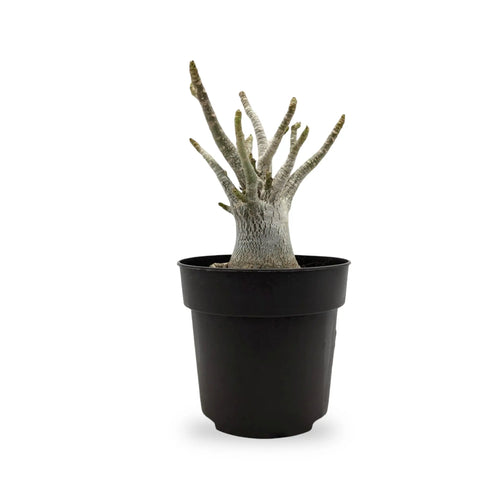Standing tall and proud in the African landscape, the Euphorbia ingens, also known as the Candelabra Tree, commands attention with its majestic beauty. With its striking sculptural form and impressive size, this iconic succulent is a true spectacle of nature. In this article, we will unravel the secrets of the Candelabra Tree, exploring its unique characteristics and the wonders it holds.
Euphorbia ingens is renowned for its candelabra-like branches, which rise high into the sky, reaching heights of up to 20 feet. Its thick trunk, adorned with thorny protuberances, adds to its allure, creating a captivating silhouette against the clear sky. Despite its thorny exterior, this desert marvel is surprisingly resilient, thriving in arid conditions and surviving harsh climates.

Beyond its breathtaking appearance, the Candelabra Tree has been revered for its medicinal properties and cultural significance. Traditional healers have long utilized various parts of this plant for their therapeutic benefits, treating a range of ailments.
Join us on a journey into the enchanting world of the Euphorbia ingens, as we delve into its captivating allure and uncover the secrets of this magnificent succulent. Let the story of the Candelabra Tree unfold, revealing the mystique and wonder of one of nature's true masterpieces.
The Euphorbia ingens is a remarkable succulent that stands out in its environment due to its distinctive features. One of the most striking aspects of this tree is its candelabra-like branches that extend upwards like arms reaching for the sky. These branches can grow to heights of up to 20 feet, creating a mesmerizing sight against the backdrop of the African landscape. The thick trunk of the Candelabra Tree is another defining characteristic, often covered in thorny protuberances that serve as a natural defense mechanism against herbivores.
The leaves of the Euphorbia ingens are reduced to small, green structures known as cladodes, which perform photosynthesis. These cladodes give the tree a unique appearance, adding to its allure and making it a popular choice for landscaping in arid regions. The Candelabra Tree also produces small, inconspicuous flowers that bloom in clusters at the ends of its branches. While the flowers may not be showy, they play a vital role in the tree's reproductive cycle, attracting pollinators and ensuring the continuation of its species.
Despite its thorny exterior and seemingly rigid structure, the Euphorbia ingens is a surprisingly resilient plant that can adapt to harsh environmental conditions. This resilience, coupled with its striking appearance, has made the Candelabra Tree a symbol of endurance and strength in the face of adversity, earning it a special place in the hearts of those who appreciate the wonders of the natural world.
The Candelabra Tree is native to the arid regions of southern Africa, where it thrives in dry, rocky landscapes with well-draining soil. This succulent is well adapted to the harsh conditions of its natural habitat, withstanding high temperatures, low rainfall, and intense sunlight. Euphorbia ingens can be found growing in clusters or scattered across the landscape, often forming striking silhouettes against the horizon.

In its native environment, the Candelabra Tree plays a crucial role in the ecosystem, providing shelter and food for a variety of desert-adapted species. Birds, insects, and small mammals are known to seek refuge in the branches of the Euphorbia ingens, finding protection from predators and the harsh elements of the desert. The tree's flowers also attract pollinators, contributing to the biodiversity of the region and ensuring the survival of other plant species in the area.
Despite its ability to thrive in arid conditions, the natural habitat of the Euphorbia ingens is increasingly under threat due to human activities such as habitat destruction and illegal harvesting. Conservation efforts are underway to protect this iconic succulent and preserve its unique ecosystem for future generations to appreciate and enjoy.
The name "Candelabra Tree" is derived from the Latin word "candelabrum," which means candlestick or chandelier. This name is a reference to the tree's distinctive branching pattern, which resembles the multiple arms of a candelabra extending upwards. The Euphorbia ingens' striking silhouette against the sky, especially at sunset when the branches cast long shadows, further reinforces its resemblance to a candelabra, creating a dramatic and captivating display.
In addition to its visual resemblance to a candelabra, the name also alludes to the tree's symbolic significance in various cultures and traditions. The upright posture of the Candelabra Tree is often associated with strength, resilience, and spiritual enlightenment, reflecting the enduring qualities of this iconic succulent. Throughout history, the Candelabra Tree has been revered for its majestic beauty and revered as a symbol of endurance in the face of adversity.

The lifecycle of the Euphorbia ingens follows a pattern typical of many succulent plants, characterized by slow growth and long periods of dormancy. The Candelabra Tree begins its life as a small seed, which germinates under favorable conditions, such as adequate sunlight and well-draining soil. As the seedling grows, it develops a strong taproot that anchors it to the ground and helps it access water deep underground.
As the Euphorbia ingens matures, it starts to produce its characteristic candelabra-like branches, which grow slowly over the course of several years. The tree's growth rate is influenced by various factors, including environmental conditions, water availability, and nutrient levels in the soil. During periods of drought or extreme heat, the Candelabra Tree may enter a state of dormancy, conserving energy and resources until conditions improve.
The reproductive cycle of the Euphorbia ingens is triggered by environmental cues such as rainfall or changes in temperature. When conditions are favorable, the tree produces flowers that attract pollinators, leading to the formation of seeds. These seeds are dispersed by wind or animals, allowing the Candelabra Tree to colonize new areas and ensure the survival of its species over time.
The Candelabra Tree has captured the imagination of people around the world, inspiring myths, legends, and folklore that celebrate its beauty and resilience. In some African cultures, the Euphorbia ingens is believed to possess mystical powers and is revered as a sacred plant with healing properties. Traditional healers use various parts of the tree, such as the sap or roots, to create remedies for ailments ranging from skin conditions to digestive disorders.
In addition to its medicinal uses, the Candelabra Tree has also been associated with protection and good fortune in many societies. Some believe that planting a Euphorbia ingens near the home can ward off evil spirits and bring blessings to the inhabitants. Others view the tree as a symbol of longevity and prosperity, with its towering branches symbolizing growth and abundance in all aspects of life.
Despite its cultural significance, the Euphorbia ingens is also a source of fascination for botanists and plant enthusiasts, who marvel at its unique adaptations and survival strategies in arid environments. The tree's ability to store water in its thick trunk and withstand extreme temperatures makes it a valuable subject for scientific study, shedding light on the intricate ways in which plants have evolved to thrive in challenging conditions.
If you are captivated by the beauty of the Candelabra Tree and wish to cultivate it in your own home, there are a few key considerations to keep in mind. Euphorbia ingens thrives in sunny locations with well-draining soil, mimicking its natural habitat in arid regions. Ensure that the tree receives ample sunlight throughout the day to promote healthy growth and flowering.
When planting a Euphorbia ingens, be mindful of its space requirements, as the tree can grow quite large over time. Provide adequate room for the branches to spread out and reach their full potential, creating a striking focal point. Water the tree sparingly, allowing the soil to dry out between waterings to prevent root rot and other moisture-related issues.
To protect yourself and others from the tree's toxic sap, wear gloves and long sleeves when handling the Euphorbia ingens, as contact with the sap can cause skin irritation and other adverse reactions. Keep children and pets away from the tree to prevent accidental ingestion or exposure to the plant's toxic compounds. With proper care and attention, the Candelabra Tree can thrive in a home garden, bringing a touch of African splendor to your outdoor space.
Like all plants, the Candelabra Tree is susceptible to a variety of pests and diseases that can impact its health and vitality. One common pest that affects Euphorbia ingens is the mealybug, a small insect that feeds on the tree's sap and leaves behind a sticky residue. Mealybugs can weaken the tree over time, leading to stunted growth and discoloration of the branches.
To combat mealybugs and other pests, it is important to inspect your Candelabra Tree regularly for signs of infestation, such as white cottony masses on the branches or discolored foliage. Prune affected branches and treat the tree with a mild insecticidal soap to eliminate the pests and prevent further damage. Avoid using harsh chemicals that can harm beneficial insects and disrupt the tree's natural ecosystem.
In addition to pests, the Candelabra Tree is also susceptible to fungal infections such as root rot, especially if the soil is kept too wet. To prevent fungal diseases, ensure that the tree is planted in well-draining soil and watered sparingly to avoid waterlogged conditions. Remove any infected plant material and improve air circulation around the tree to reduce the risk of fungal spore spread.










